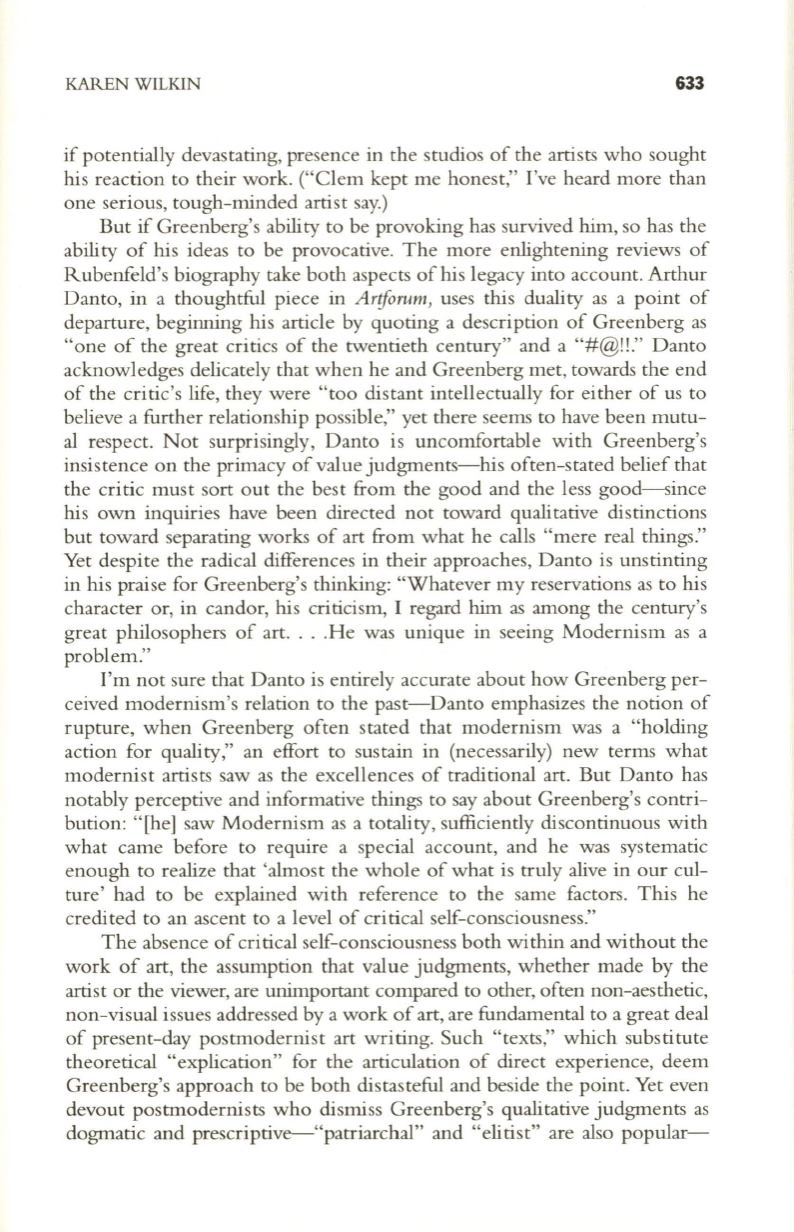
KAREN WILKIN
633
if potentially devastating, presence in the studios of the artists who sought
his reaction to their work. ("Clem kept me honest," I've heard more than
one serious, tough-minded artist say.)
But
if
Greenberg's ability to be provoking has survived him, so has the
ability of his ideas to be provocative. The more enlightening reviews of
Rubenfeld's biography take both aspects of his legacy into account. Arthur
Danto, in a thoughtful piece in
Ariforum,
uses this duality as a point of
departure, beginning his article by quoting a description of Greenberg as
"one of the great critics of the twentieth century" and a
"#@!!."
Danto
acknowledges delicately that when he and Greenberg met, towards the end
of the critic's life, they were "too distant intellectually for either of us to
believe a further relationship possible," yet there seems to have been mutu–
al respect. Not surprisingly, Danto is uncomfortable with Greenberg's
insistence on the primacy of value judgments-his often-stated belief that
the critic must sort out the best from the good and the less good-since
his own inquiries have been directed not toward qualitative distinctions
but toward separating works of art from what he calls "mere real things."
Yet despite the radical differences in their approaches, Danto is unstinting
in his praise for Greenberg's thinking: "Whatever my reservations as to his
character or, in candor, his criticism, I regard
him
as among the century's
great philosophers of art. . ..He was unique in seeing Modernism as a
problem."
I'm not sure that Danto is entirely accurate about how Greenberg per–
ceived modernism's relation to the past-Danto emphasizes the notion of
rupture, when Greenberg often stated that modernism was a "holding
action for quality," an effort to sustain in (necessarily) new terms what
modernist artists saw as the excellences of traditional art. But Danto has
notably perceptive and informative things to say about Greenberg's contri–
bution: "[he] saw Modernism as a totality, sufficiently discontinuous with
what came before to require a special account, and he was systematic
enough to realize that 'almost the whole of what is truly alive in our cul–
ture' had to be explained with reference to the same factors. This he
credi ted to an ascent to a level of cri tical self-consciousness."
The absence of critical self-consciousness both within and without the
work of art, the assumption that value judgments, whether made by the
artist or the viewer, are unimportant compared to other, often non-aesthetic,
non-visual issues addressed by a work of art, are fundamental to a great deal
of present-day postmodernist art writing. Such "texts," which substitute
theoretical "explication" for the articulation of direct experience, deem
Greenberg's approach to be both distasteful and beside the point. Yet even
devout postmodernists who dismiss Greenberg's qualitative judgments as
dogmatic and prescriptive-"patriarchal" and "elitist" are also popular-


